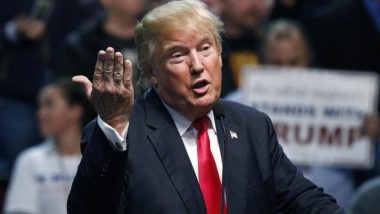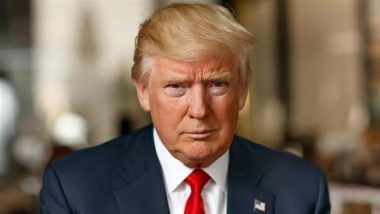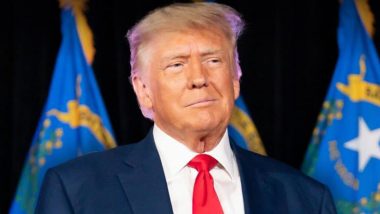Donald Trump in a closed cabinet meeting announced U.S. would impose tariffs on steel and aluminum being imported to the country. The president said that his administration will apply duties of 25% and 10% for imported steel and aluminum respectively. The tariffs will be put in place by next week.
Trump’s decision comes after months of frenetic lobbying by U.S. steel manufacturers that have faced stiff competition from other steel producing nations like China, Russia and the European Union countries. Trump had hinted at possible duty impositions in December 2017 as well.
Trump announces steel tariffs: 25% on imported steel, 10% on imported aluminum.
— Michael McKee (@mckonomy) March 1, 2018
The announcement was made to steel and aluminum executives at the White House with Trump emphasizing, “Those tariffs will remain for a long period of time."
Donald Trump’s action is targeted towards shoring up his domestic popularity as bringing jobs back to laid-off steel workers was one of his campaign promises in 2016. His decision to impose duties on steel comes just a month after a round-of layoffs rendered 150 people unemployed at the steel production plant of Arcelor-Mittal US in Pennsylvania.
Trump’s decision had a direct impact on the U.S. stock market with the Dow Jones Industrial Average initially falling more than 570 points, with heavy losses for manufacturers like Caterpillar and Boeing. The index closed down 420 points and the S&P 500 and Nasdaq both dropped on the day.
This is because American companies that make things out of steel represent a much broader sector of the economy than the raw metal industries Trump is trying to shore up. American-made finished products could also become less competitive if the U.S. trading partners impose their own tariffs in retaliation. The proposed measures will in the end actually undermine American job growth.
In order to push through the unilateral imposition of tariffs, the President has used “Section 232” of a 1962 U.S. trade law, which allows for trade restrictions to protect national security. It was not immediately clear if the tariffs would exempt certain trading partners.
Our Steel and Aluminum industries (and many others) have been decimated by decades of unfair trade and bad policy with countries from around the world. We must not let our country, companies and workers be taken advantage of any longer. We want free, fair and SMART TRADE!
— Donald J. Trump (@realDonaldTrump) March 1, 2018
Reaction to Trump’s announcement has been swift with Canada and the EU decrying the U.S.’s protectionist move. Calling the tariffs “absolutely unacceptable,” Canadian Foreign Affairs Minister Chrystia Freeland promised “responsive measures” if Canada does not get a last-minute exemption. On the other side of the Atlantic, Jean Claude Juncker the European Commission chief executive said, “We strongly regret this step which appears to represent a blatant intervention to protect U.S. domestic industry and not to be based on any national security justification.” He openly indicated at reciprocal counter-measures saying, “We will not sit idly while our industry is hit with unfair measures that put thousands of European jobs at risk ... The EU will react firmly and commensurately to defend our interests.”
Our Steel and Aluminum industries (and many others) have been decimated by decades of unfair trade and bad policy with countries from around the world. We must not let our country, companies and workers be taken advantage of any longer. We want free, fair and SMART TRADE!
— Donald J. Trump (@realDonaldTrump) March 1, 2018
India is yet to respond to the U.S. government’s announcement but the tariffs will impact the Indian steel export market as well. For the last decade, U.S. is among the top ten export market for India’s stainless steel. India had exported 384.8 thousand metric tons of steel to the U.S. in 2016 and 558.4 thousand metric tons in 2015. India’s total steel exports for the year 2016 stands at 10 million metric tons.
Donald Trump’s measure is also aimed at attacking U.S.’s burgeoning trade deficit. In 2017, the total U.S. trade deficit was $566 billion. Steel contributes a significant portion to the trade deficit as the U.S. is the world’s biggest importer of steel. U.S. imports in 2016 represented about 8 percent of all steel imported globally.
However, members of Trump’s own party have questioned the wisdom of the move. “Every time you do this, you get a retaliation, and agriculture is the number one target,” Kansas Senator Pat Roberts told reporters. China has indicated it could retaliate against U.S. steel tariffs by targeting imports of U.S. agricultural commodities such as soybeans, of which America is the largest supplier.
The last time a steel tariff was imposed by the U.S. was signed off by President George W. Bush in 2002. Bush ended up lifting those tariffs 16 months ahead of schedule. The U.S. International Trade Commission had found that they had created more costs than gains.
(The above story first appeared on LatestLY on Mar 02, 2018 11:50 AM IST. For more news and updates on politics, world, sports, entertainment and lifestyle, log on to our website latestly.com).













 Quickly
Quickly





















